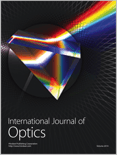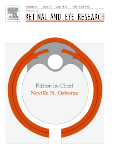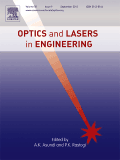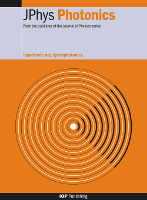
Journal of Innovative Optical Health Sciences
Scope & Guideline
Illuminating Pathways in Optical Health Sciences
Introduction
Aims and Scopes
- Advanced Optical Imaging Techniques:
The journal covers cutting-edge optical imaging modalities such as photoacoustic microscopy, optical coherence tomography (OCT), and fluorescence microscopy, focusing on their applications in biomedical research and clinical diagnostics. - Optical Biosensing and Nanotechnology:
Research on the development and application of optical biosensors and nanomaterials for disease detection and treatment, including photodynamic therapy and targeted drug delivery. - Machine Learning and Image Processing:
The integration of artificial intelligence and machine learning techniques for improving image analysis, segmentation, and classification in medical imaging. - Biophotonics and Therapeutic Applications:
Exploration of biophotonics applications in therapeutic interventions, including phototherapy and biophotonic approaches to tissue engineering and regenerative medicine. - Multimodal Imaging Approaches:
Research that combines various imaging modalities and techniques to enhance diagnostic capabilities and treatment monitoring.
Trending and Emerging
- Integration of AI and Machine Learning:
The increasing application of artificial intelligence and machine learning in optical imaging and analysis is a significant trend, enhancing the efficiency and accuracy of diagnostic processes. - Focus on Personalized Medicine:
Emerging themes in personalized medicine, particularly in how optical technologies can be tailored for individual patient diagnostics and treatments, are gaining prominence. - Advancements in Nanotechnology for Health Applications:
Research involving nanotechnology, particularly in photothermal therapy and drug delivery systems, is on the rise, highlighting innovative approaches to cancer treatment and imaging. - Real-time Imaging Techniques:
The development of real-time imaging methods, such as high-speed optical coherence tomography and photoacoustic imaging, is an emerging focus, aimed at improving intraoperative and diagnostic capabilities. - Optogenetics and Neuromodulation:
There is an increasing interest in the application of optical techniques in neuromodulation and optogenetics, reflecting a growing recognition of their potential in neuroscience and therapeutic interventions.
Declining or Waning
- Traditional Imaging Modalities:
There is a noticeable decrease in publications focusing on conventional imaging techniques, such as standard microscopy and basic imaging approaches, as newer, more advanced methodologies gain traction. - Basic Theoretical Studies:
Research that primarily focuses on theoretical aspects of optics and imaging without direct application to health sciences is becoming less frequent, as the journal increasingly emphasizes applied research. - Non-optical Diagnostic Methods:
There has been a waning interest in non-optical methods of diagnosis, with a shift toward optical technologies, suggesting a consolidation of focus on the unique contributions of optical methodologies.
Similar Journals

Eye and Vision
Cultivating a community dedicated to eye care excellence.Eye and Vision, published by BMC, is a leading open-access journal dedicated to the dynamic field of ophthalmology and visual sciences. With its ISSN 2326-0246 and E-ISSN 2326-0254, the journal has established itself as a premier platform for innovative research and clinical studies, achieving impressive rankings in 2023 as Q1 in both Health Professions (Miscellaneous) and Ophthalmology categories. The journal's commitment to accessible knowledge since its transition to open access in 2015 enhances its global reach, allowing researchers, clinicians, and students to share and access top-tier studies and advancements in the field. Located in the United Kingdom and delivering influential insights from 2014 through to 2024, Eye and Vision holds significant relevance, with a Scopus ranking placing it in the 99th percentile for Health Professions and the 93rd percentile for Ophthalmology, making it an essential resource for those looking to stay at the forefront of eye research and vision science.

International Journal of Optics
Exploring the Frontiers of Optical ScienceWelcome to the International Journal of Optics, a distinguished publication dedicated to advancing the field of optics and its interdisciplinary applications. Published by HINDAWI LTD, this open-access journal has been pivotal in fostering knowledge since its inception in 2009. With a robust focus on atomic and molecular physics as well as electronic, optical, and magnetic materials, the journal has carved its niche within Q3 quartile rankings in these categories for 2023, signifying its growing impact and relevance in the scientific community. Researchers and professionals will find a rich repository of innovative and cutting-edge research articles that not only address fundamental aspects of optics but also explore practical applications across various domains. The journal's aim is to promote high-quality research dissemination, enhancing collaboration among scientists and ensuring that pivotal findings reach a global audience. Join us in exploring the dynamic world of optics—where your contributions help shape the future of science.

Current Optics and Photonics
Shaping Tomorrow's Optics Through Scholarly DialogueCurrent Optics and Photonics is a premier journal published by the Optical Society Korea, focusing on the dynamic and evolving fields of optics and photonics. With an ISSN of 2508-7266 and E-ISSN 2508-7274, it provides a comprehensive platform for scholarly communication, emphasizing innovations, advances in technology, and theoretical developments in atomic and molecular physics and optics. Situated in South Korea's vibrant academic landscape, this open access journal aims to bridge the gap between theoretical research and practical applications, fostering collaboration and knowledge sharing among researchers, professionals, and students alike. Although currently ranked in the Q3 category for both Atomic and Molecular Physics and Optics, with a Scopus rank of #183/224, it showcases significant contributions that enhance understanding in these critical areas. The journal encourages submission of original research articles, reviews, and technical notes, with the objective of driving forward the conversation in optics and photonics throughout its converged years from 2017 to 2024. Embrace the opportunity to contribute to this expanding field and become part of a community that is at the forefront of scientific discovery.

PROGRESS IN RETINAL AND EYE RESEARCH
Driving Breakthroughs in Sensory SystemsPROGRESS IN RETINAL AND EYE RESEARCH, published by PERGAMON-ELSEVIER SCIENCE LTD, is a premier journal dedicated to the advancement of knowledge in the fields of ophthalmology and sensory systems. With an impressive impact factor and a Q1 category ranking in both Ophthalmology and Sensory Systems as of 2023, this journal exemplifies excellence in research dissemination. Given its stature, it ranks #1 out of 137 in Ophthalmology and #1 out of 42 in Neuroscience - Sensory Systems, placing it within the top percentile of scientific publications in these domains. The journal has been actively contributing to the field since its inception in 1994 and continues to be a vital resource for researchers, clinicians, and students seeking the latest insights and breakthroughs in the understanding of retinal diseases and eye health. While it maintains a traditional subscription model, the journal remains committed to publishing high-quality, peer-reviewed articles that drive forward the frontiers of eye research and therapeutic innovation. With its strong scientific rigor and a vast array of articles, PROGRESS IN RETINAL AND EYE RESEARCH is indispensable for anyone invested in the study of visual sciences.

eLight
Connecting Researchers to Transformative Insights in ScienceeLight is a leading academic journal published by SPRINGER NATURE, dedicated to the dynamic field of Atomic and Molecular Physics, as well as Electronic, Optical, and Magnetic Materials. Launched in 2021, the journal has quickly established itself as a reputable source of cutting-edge research, evidenced by its impressive Q1 quartile rankings in both categories for 2023, alongside remarkable Scopus rankings that place it in the top 2% of its fields. With a commitment to advancing knowledge and fostering innovation, eLight invites contributions from researchers, professionals, and students who are passionate about exploring new frontiers in these critical areas of study. Hitting a critical intersection of physics and materials science, the journal provides an open forum for the dissemination of experimental findings, theoretical studies, and application-based research, ensuring accessibility to vital discoveries that drive progress in technology and academia. Located in Singapore, eLight is poised to make significant contributions to the scientific community until at least 2024, and beyond.

OPTICS AND LASERS IN ENGINEERING
Driving Progress in Engineering with Light and LasersOPTICS AND LASERS IN ENGINEERING, published by Elsevier Science Ltd, is a premier journal dedicated to advancing the field of optics and laser technology in engineering applications. With a robust ISSN of 0143-8166 and E-ISSN 1873-0302, this journal is positioned within the top quartile (Q1) across several categories, including Atomic and Molecular Physics, Electrical Engineering, and Mechanical Engineering as of 2023, showcasing its prestige and impact in the scientific community. The journal has consistently ranked high in Scopus, notably within the top 10% for Mechanical Engineering and Electronic, Optical, and Magnetic Materials research. Since its inception in 1980, OPTICS AND LASERS IN ENGINEERING has served as a vital platform for disseminating cutting-edge research, fostering innovation and collaboration among researchers, professionals, and academia. Though it does not currently offer Open Access options, its high impact factor and selective publication process ensure that articles reach a wide audience while maintaining rigorous academic standards. Researchers and students alike are encouraged to engage with this influential journal to contribute to and stay abreast of advancements in optical technologies and their engineering applications.

Journal of Physics-Photonics
Pioneering Research at the Intersection of Light and ScienceJournal of Physics-Photonics, published by IOP Publishing Ltd in the United Kingdom, is an esteemed Open Access journal that has been at the forefront of research in the field of photonics since its inception in 2018. With an impressive portfolio, the journal has achieved Q1 ranking in 2023 across multiple disciplines, including Atomic and Molecular Physics, Electrical and Electronic Engineering, and Electronic, Optical, and Magnetic Materials. This positions it among the leading journals in these areas, reflecting its significant influence and contribution to advancing knowledge and innovation. The journal aims to disseminate high-quality research findings that encompass a wide range of topics in photonics, promoting interdisciplinary approach that fosters collaboration among researchers, professionals, and students. With its commitment to open access, Journal of Physics-Photonics ensures that groundbreaking research is accessible to all, empowering a global audience to engage with and benefit from the latest advancements in photonic technologies.

BioChip Journal
Empowering Interdisciplinary Discoveries in Biochip ScienceBioChip Journal, published by the Korean Biochip Society (KBCS), is a renowned academic platform dedicated to advancing the fields of bioengineering, biomedical engineering, biotechnology, and electrical and electronic engineering. With its ISSN 1976-0280 and E-ISSN 2092-7843, this esteemed journal has established itself as a valuable resource for researchers, professionals, and students alike, providing them with cutting-edge research and insights since its inception in 2008. The journal has earned a commendable standing in the academic community, achieving Q2 ranking across key categories, thereby placing it amongst the top-tier publications. With its impressive Scopus rankings, including a top 10% position in Electrical and Electronic Engineering and a strong showing in both Biomedical Engineering and Biotechnology, BioChip Journal plays a vital role in disseminating innovative biochip technologies and applications. The journal continues to invite groundbreaking studies and reviews that promote the interdisciplinary collaboration essential for the future of biochip research, ultimately contributing to advancements in healthcare, diagnostics, and therapeutics.

Biomedical Optics Express
Bridging Disciplines with Optical ExcellenceBiomedical Optics Express, published by the prestigious Optica Publishing Group, is an open-access journal that has been at the forefront of the field of biomedical optics since its inception in 2011. With an ISSN of 2156-7085, this journal has established itself as a premier platform for disseminating high-quality research that spans an array of topics in atomic and molecular physics, optics, and biotechnology. As a testament to its scholarly impact, it is currently ranked in the Q1 category for both Atomic and Molecular Physics and Biotechnology, reflecting its commitment to excellence within these disciplines. The journal features cutting-edge articles that foster innovation and collaboration among researchers, professionals, and students who are passionate about applying optical technologies to solve pressing challenges in medicine and biology. Based in the United States, Biomedical Optics Express continues to shape the future of optical science and its applications, inviting contributions that inspire and drive forward the boundaries of knowledge.

Journal of VitreoRetinal Diseases
Unveiling the complexities of vitreo-retinal disorders.Journal of VitreoRetinal Diseases is a leading publication in the field of ophthalmology, specifically focusing on the complex landscape of vitreo-retinal conditions. Released by SAGE Publications Inc, this journal plays a crucial role in advancing the understanding and treatment of retinal diseases through high-quality, peer-reviewed research. With an ISSN of 2474-1264 and an E-ISSN of 2474-1272, the journal has gained recognition since its inception in 2017, currently ranking in the Q3 category of ophthalmology based on its Scopus metrics. Positioned within the 31st percentile among its peers, the journal provides a platform for the dissemination of innovative findings and clinical practices. Although it operates under a traditional access model, the significance of its contributions is profound, making it an essential resource for researchers, healthcare professionals, and students dedicated to improving patient outcomes in retinal health.